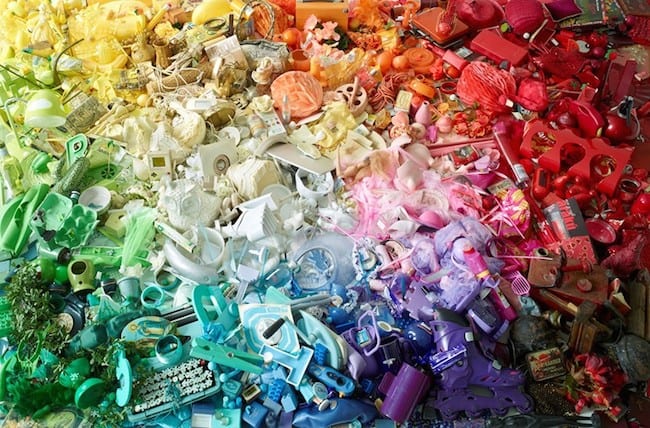Entropy and the eventual heat death of the universe is fascinating, but unfortunately these topics tend to give people the willies. Luckily photographer Dan Tobin Smith recently proved that existence as we know it ending as an inert mass can be colorful, even cute. Just try to ignore the part of yourself that starts screaming when you see the mess.

You’re looking at images from Smith’s recent project The First Law of Kipple, which showed at the London Design Festival this year. It takes its name from a line from Philip K. Dick’s science fiction novel Do Android’s Dream of Electric Sheep? Kipple, as Dick describes it, is a a mass of steadily-accumulating junk that seems to grow of its own will. Dick’s quote that introduces the piece is simultaneously silly and terrifying: “No one can win against kipple, he said, except temporarily and maybe in one spot.” It’s like Vonnegut’s ice-nine as a giant wave of garbage. We’re all doomed. Hooray!
According to a description of the project the idea of kipple parallels with the Second Law of Thermodynamics, which describes how heat in the universe flows from a hot ordered state into a cold disordered one. This law is extra special because some people believe that this is how the universe will end.

It’s not an easy concept to witness happening in front of you, but when pictured as a heap of refuse it becomes a little easier and stirs those familiar feelings of existential anxiety one tries their best to ignore.
Leading up to the festival Smith launched the website CallForKipple, on which he asked people to donate their own “useless, used-up or pointless stuff” that has been growing, cancer like, in their lives over the years. His end goal was to carpet an entire floor and mezzanine of a studio with 200-square meters of chromatically-arranged junk.

Smith’s choice to arrange the detritus by size and color, then to cut rigid paths through it is interesting, not only because it gives the piece more of a purpose than turning a studio space into a temporary landfill. It’s an attempt (a vain one considering the growing mass of kipple festering outside the studio’s walls) to impose order on chaos. It reminds me of an entropy thought experiment created by James Clerk Maxwell in 1867. Called “Maxwell’s Demon” it suggests a way that one could defeat entropy.
To run the experiment (and save the universe) you’d need a jar of gas molecules at equilibrium divided by an insulated wall which has a tiny door. At the door sits a longsuffering being, the “demon,” whose lousy job it is to open the door to allow only faster molecules of gas through. Over time, the side with the faster molecules will heat up, which decreases entropy. Bang! What do you think about that, Second Law of Thermodynamics, ya putz!?
I mention this because Smith’s role with the piece seems similar to that of Maxwell’s Demon. He’s given individual pieces of refuse, weighted with the threat of devouring the planet, and arranges them in a way that gives them form and purpose. It’s nice to think about. It’s pleasant. Inspiring, even.
But no one can win against kipple.
No one.
Bill Rodgers is a Contributing Editor at CFile.
Any thoughts about this post? Share yours in the comment box below.









Dan Tobin Smith, The First Law of Kipple, 2014

Why not a word referencing fellow Brit Tony Cragg’s work in the late 70’s early 80’s
“New Stones, Newton’s Tones”, bits of worthless discarded plastic that were collected, sorted by color and installed on the floor or on the wall. Brilliant sculptural works well ahead of their time. How does Cragg get left out of this conversation?